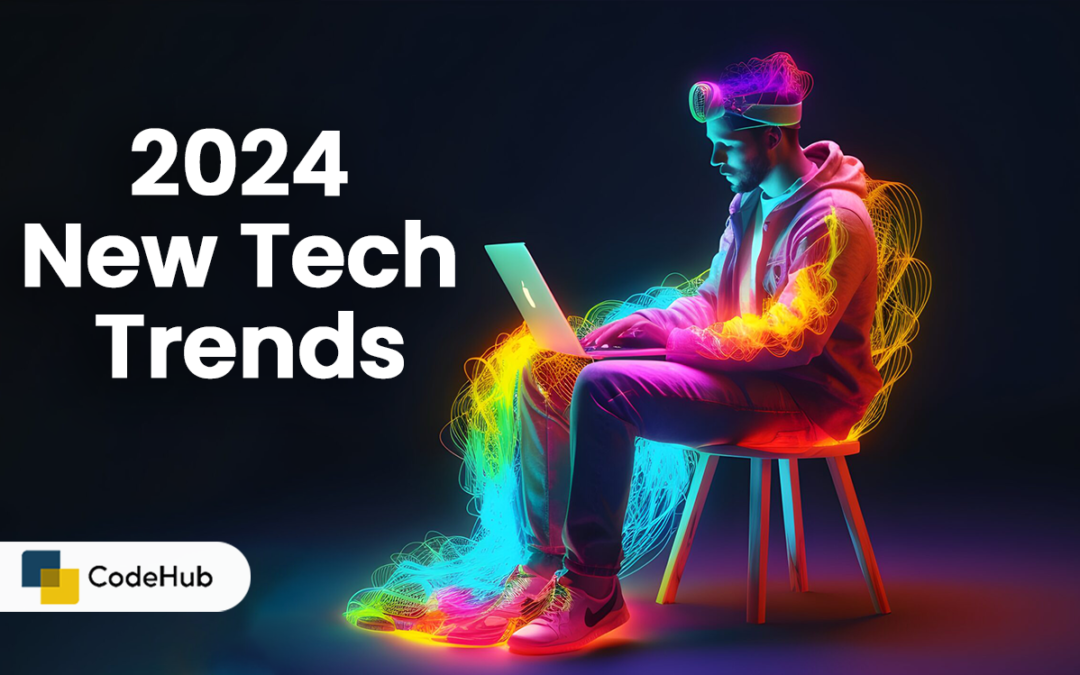The year 2024 is expected to be a year of innovation and transformation, as new technologies emerge and mature, and as existing technologies evolve and converge. These technologies will have a profound impact on various fields and domains, such as business, education, health, entertainment, and society. These technologies will also create new opportunities and challenges, and will require new skills and mindsets.
In this blog post, we will introduce you to some of the 2024 new tech trends, based on their novelty, potential, and relevance. These trends are not ranked or listed in any particular order, and they cover various categories and sectors, such as artificial intelligence, biotechnology, climate change, computing, cybersecurity, space science, and more. Let’s take a look at them.
Generative AI
Generative AI is a branch of artificial intelligence that focuses on creating new content or data, such as images, text, music, or code, based on existing data or models. Generative AI can use various techniques, such as generative adversarial networks (GANs), variational autoencoders (VAEs), or transformers, to learn from data and generate realistic and diverse outputs.
Generative AI is not a new concept, but it has become more accessible and powerful in recent years, thanks to the advances in hardware, software, and data. Generative AI can enable and enhance various applications and domains, such as design, art, entertainment, education, and research. Generative AI can also pose new ethical and social issues, such as authenticity, ownership, and responsibility.
For example, generative AI can help designers and artists create new and original designs and artworks, by providing inspiration, feedback, and collaboration. Generative AI can also help entertainers and educators create new and engaging content and experiences, by providing personalization, interactivity, and immersion. Generative AI can also help researchers and scientists create new and useful data and models, by providing simulation, experimentation, and discovery.
According to Gartner, generative AI will significantly alter 70% of the design and development effort for new web applications and mobile apps by 2026. According to Accenture, democratized generative AI will be one of the key tech trends for 2024, as it will allow more people to access and use generative AI tools and platforms.
Spatial Computing
Spatial computing is a new paradigm of computing that integrates the physical and digital worlds, by using sensors, cameras, and algorithms to map, understand, and augment the 3D space and objects around us. Spatial computing can use various technologies, such as augmented reality (AR), virtual reality (VR), mixed reality (MR), or extended reality (XR), to create immersive and interactive experiences.
Spatial computing is not a new phenomenon, but it has become more mainstream and affordable in recent years, thanks to the advances in devices, networks, and software. Spatial computing can enable and enhance various applications and domains, such as gaming, education, health, tourism, and industry. Spatial computing can also create new opportunities and challenges, such as accessibility, privacy, and safety.
For example, spatial computing can help gamers and educators create and enjoy immersive and interactive games and learning environments, by providing realistic and dynamic graphics, audio, and haptics. Spatial computing can also help health and tourism professionals and users create and access immersive and interactive health and travel services, by providing diagnosis, treatment, guidance, and information. Spatial computing can also help industry and manufacturing professionals and workers create and optimize immersive and interactive workspaces and processes, by providing monitoring, control, automation, and collaboration.
According to IDC, the global spending on AR/VR products and services will reach $72.8 billion in 2024, with a compound annual growth rate of 54%. According to MIT, Spacetop is one of the tech trends that will define 2024, as it will provide a 3D interactive workspace for augmented reality.
Bioprinting
Bioprinting is a process of using 3D printing technology to create biological structures, such as tissues, organs, or implants, by depositing layers of biomaterials, such as cells, proteins, or polymers. Bioprinting can use various techniques, such as inkjet, extrusion, or laser, to create complex and precise structures that can mimic the natural functions and properties of living tissues and organs.
Bioprinting is not a new technology, but it has become more advanced and accessible in recent years, thanks to the advances in biotechnology, nanotechnology, and engineering. Bioprinting can enable and enhance various applications and domains, such as medicine, research, cosmetics, and food. Bioprinting can also raise new ethical and social issues, such as regulation, safety, and acceptance.
For example, bioprinting can help medicine and research professionals and users create and use customized and functional tissues and organs, by providing transplantation, regeneration, testing, and modeling. Bioprinting can also help cosmetics and food professionals and users create and use alternative and sustainable products, by providing skin, hair, and meat.
According to Research and Markets, the global bioprinting market will reach $4.70 billion by 2025, with a compound annual growth rate of 35.4%. According to Forbes, bioprinting will be one of the top tech trends in 2024, as it will revolutionize health care and life sciences.
Conclusion
The year 2024 is expected to be a year of innovation and transformation, as new technologies emerge and mature, and as existing technologies evolve and converge. These technologies will have a profound impact on various fields and domains, such as business, education, health, entertainment, and society. These technologies will also create new opportunities and challenges, and will require new skills and mindsets.
In this blog post, we have introduced you to some of the 2024 new tech trends, based on their novelty, potential, and relevance. We hope you enjoyed reading this blog post, and learned something new and interesting about these trends. If you have any questions, comments, or feedback, please feel free to share them with us. Thank you for your attention and interest

